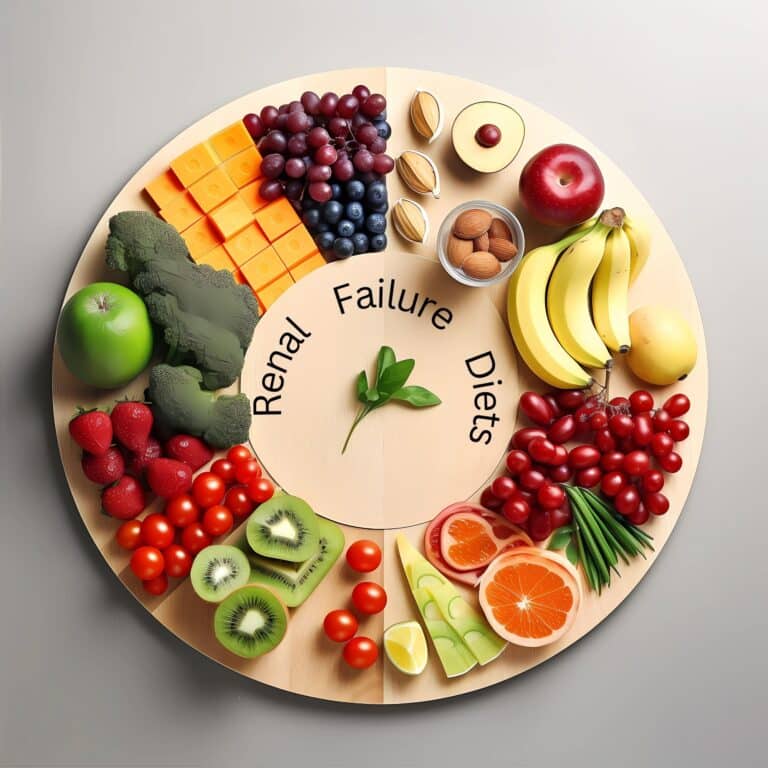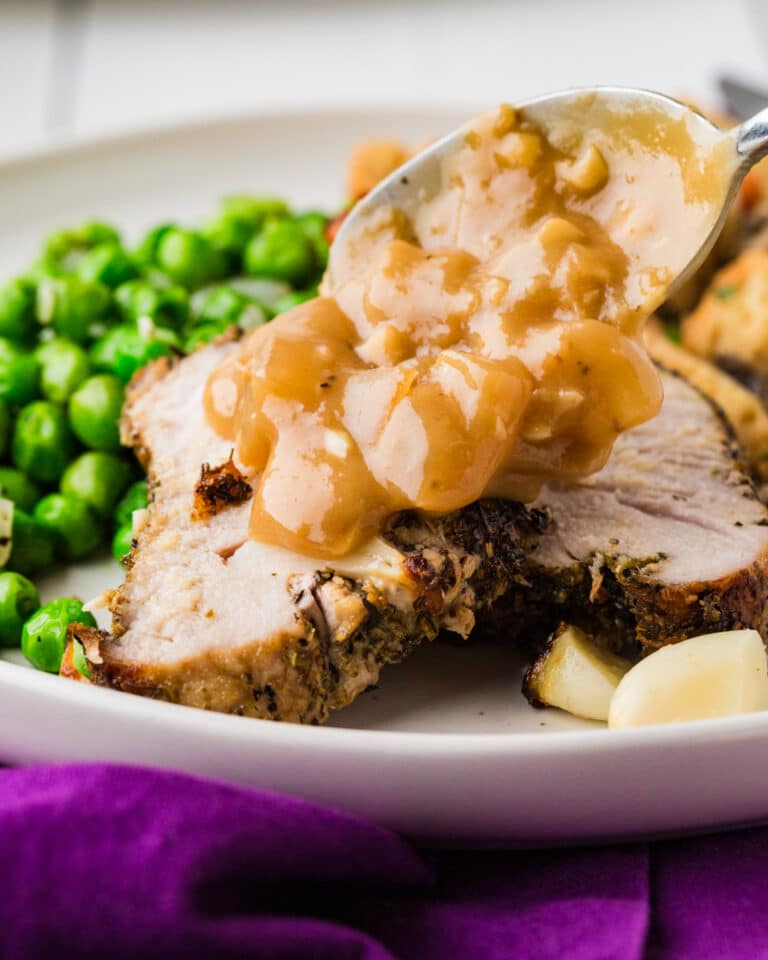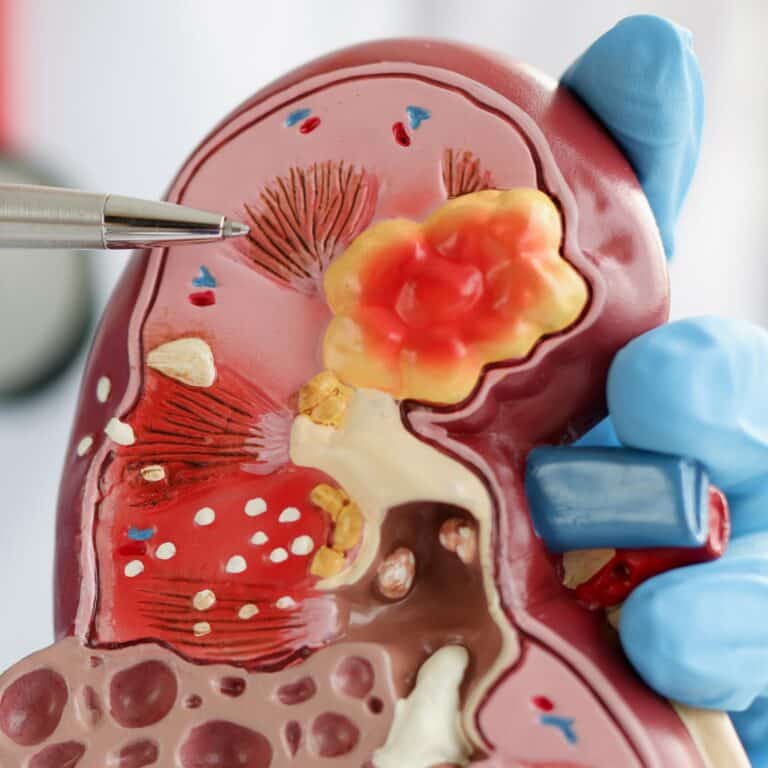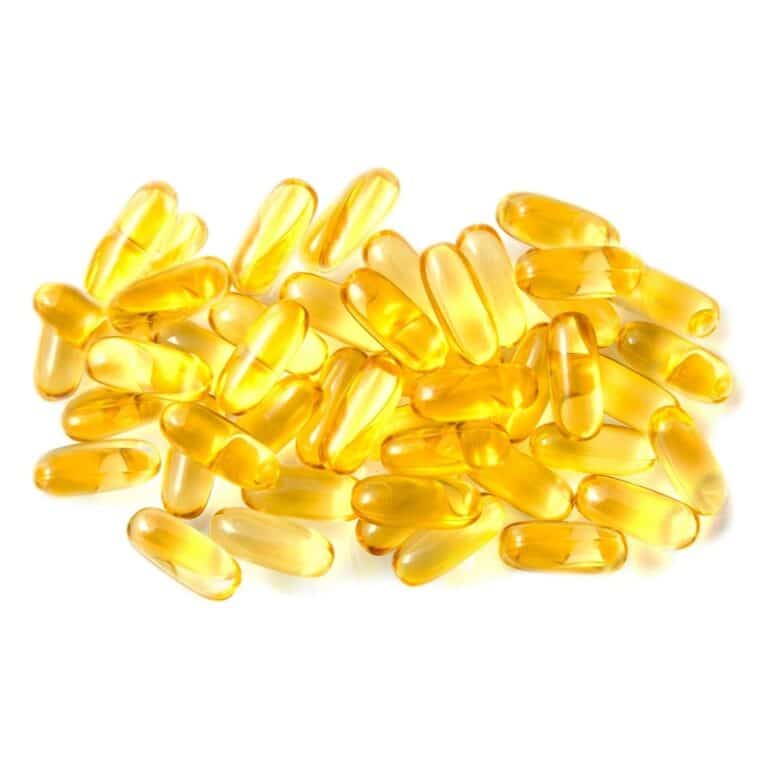Renal Diet Food List
Eating a healthy diet is an important part of managing kidney disease. A renal diet requires careful planning to get the right balance of minerals, vitamins, and proteins for optimal health.
This article will explore how people with kidney disease can benefit from following a chronic kidney disease diet food list tailored to their specific needs.
For those living with chronic kidney disease, it can be overwhelming trying to figure out what foods are safe or best to eat as part of their daily meals.
Fortunately, there are plenty of resources available that provide helpful guidelines on which foods should be included in your renal diet menu plan.
With these tips and tricks, you'll have no trouble finding delicious and nutritious recipes that fit within your dietary restrictions while still providing all the essential nutrients your body needs!
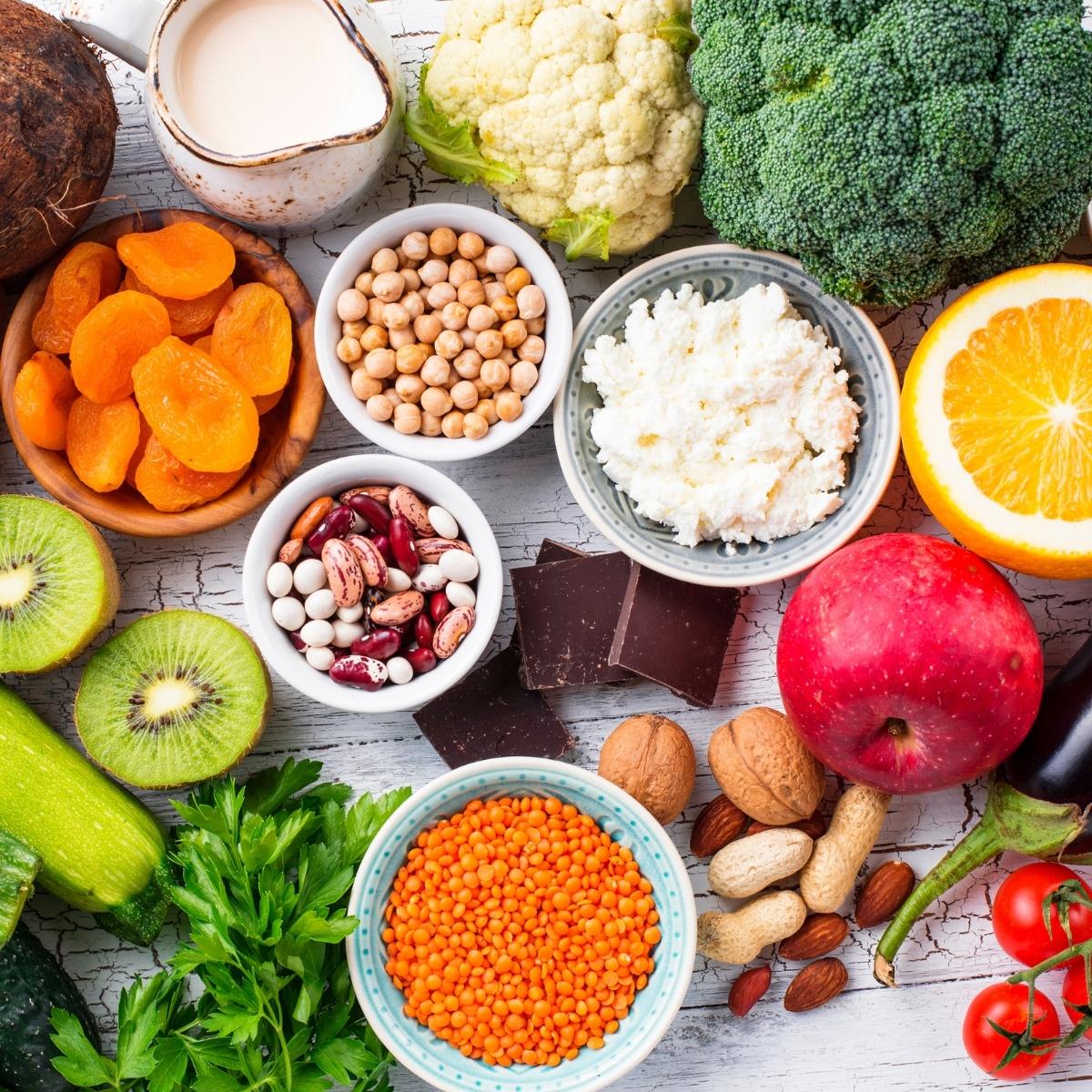
Jump to:
- Definition
- Food Groups To Include
- Food Groups To Avoid
- Diabetic Renal Diet
- Cardiac Renal Diet
- How To Read A Label For CKD Foods
- The National Renal Diet
- Printable Chart
- High Protein Foods
- Changes Based On Stage Of CKD
- Over-The-Counter Remedies
- Prescription Medications
- FAQs for Renal Diet Food List
- Get Started For The Health Benefits!
Definition
Renal diets are special diets that are specifically tailored to the needs of someone with chronic kidney disease. They involve restricting certain nutrients and fluids, such as sodium, potassium, phosphorus, and protein.
People with kidney disease need to be aware of how much and what kind of food they should be eating to stay healthy. Eating a renal diet can help reduce the workload of the kidneys and reduce the symptoms of kidney disease.
With the right modifications, you can still enjoy your favorite dishes even on this type of diet. Without a doubt, there is food for your stage of chronic kidney disease.
Renal Diets
If you or someone you know has been diagnosed with kidney disease, chances are you have heard the term 'renal diet' thrown around. But what is a renal diet?
In short, it is an eating plan that helps limit certain food and beverage intake to help protect you from further kidney damage. Meal planning, fluid intake, healthy snacks, and sodium substitutes all come into play when following this special kind of diet. Doing healthy eating with a dialysis diet plan comes with time and patience, but the food options are there!
When creating meal plans for those on a renal diet, the focus should be placed on limiting foods high in phosphorus, potassium, protein, and salt which can put extra strain on the kidneys. Eating smaller meals more often throughout the day may also prove beneficial as opposed to three large meals.
Fluid intake needs to be closely monitored; as drinking too much water could lead to swelling due to excess fluid buildup in the body. Healthy snack options for those on a renal diet include fresh fruits or nuts.
Sodium substitutes such as Mrs. Dash seasoning blend can offer flavor to dishes without adding unwanted sodium content.
Kidney-friendly diets may seem difficult at first but by taking small steps and understanding how food affects our bodies, we can learn how best to nourish ourselves while keeping our kidneys safe.
Nutrient Restrictions
When following a renal diet, there are certain nutrient restrictions that should be taken into account to protect the kidneys from further damage.
The main nutrients often restricted in a renal diet are phosphorus, potassium, sodium and protein. Firstly, phosphorus limitation must be practiced as high levels of it can cause calcium deposits in the body which may lead to bone disease.
Secondly, potassium and sodium (renal diet sodium limit) content should also be limited; too much salt or potassium could cause complications due to the decline in renal function.
Finally, protein intake should be in close watch.
For those on earlier stages of kidney disease, a low-protein diet can help further decline in kidney function. For those on dialysis due to advanced kidney disease, a high-protein diet is optimal for keeping them healthy.
All of these factors need to be considered carefully when creating meal plans for those on a renal diet so they get the nutrients they need without risking their health. With patience and creativity, you can find delicious recipes that meet these dietary restrictions!

Food Groups To Include
When it comes to a kidney-friendly food list, it's important to include a variety of foods from all the food groups. Fruits, vegetables, dairy, whole grains, legumes, fish, lean meats, nuts, seeds, and healthy fats are all great additions.
Condiments for kidney disease, low-sugar foods, low-potassium foods, low-phosphorus foods, and low-protein foods should also be included in the diet to ensure proper nutrition.
It's essential to make sure to get the right balance of all these foods in order to have a healthy diet.
Fruits
When it comes to kidney friendly fruits, portion control is key! This means you can have a few servings of fruit each day without going overboard.
To help with sodium and potassium intake, make sure to opt for fresh or frozen varieties instead of canned fruit as they contain higher levels of these minerals.
Carb counting also plays an important role in your renal diet: choose low carb fruits like strawberries, blueberries, cherries, and apples. Make sure to be mindful of fruits that contain high levels of potassium such as bananas and avocados.
Vegetables
Vegetables are excellent sources of vitamins and minerals in a renal diet, and the key is to make sure you're getting the most out of them.
That means eating seasonal produce when possible - it's fresher and more nutrient-rich. It also pays off to pay attention to portion sizes; aim for half your plate filled with veggies at each meal.
Don't forget food safety for people with kidney disease either: wash all fruits and vegetables before consuming or cooking them. Fresh food items are also preferred over canned vegetables since the latter may have additives.
Meal planning can help you stay on track too, so take some time each week to plan out what recipes you'd like to try using fresh, healthy ingredients.
Grains
When it comes to following a renal diet, grains can be an important part of meal planning. When preparing grains for your meals, focus on using cooking methods that are low in salt and fat such as baking or steaming.
Also, try to include whole grain options like brown rice, oats (is quaker oats good for kidneys?), quinoa (is quinoa good for kidney disease?), buckwheat, and barley when possible.
These foods provide essential vitamins and minerals while helping you get the daily recommended calorie intake per day. It's also important to pay attention to food quality by checking ingredient labels so you know what ingredients have been added.
Make sure there are no hidden sources of sodium or potassium! In addition to these tips, consider mixing up different types of grains throughout the week for variety in your meals. This will help keep things interesting while ensuring you're getting all the nutrients you need from this food group.
Food Groups To Avoid
Sodium, potassium, and phosphorus are important to watch when it comes to a renal diet. We should avoid high-sodium foods, such as canned foods, salted snacks, frozen dinners, convenience foods, and processed lunch meats.
High-potassium foods like bananas, oranges, and spinach should also be limited or avoided. And high-phosphorus foods, like dairy products, nuts, and legumes, should be limited or avoided as well. Let's talk about these food groups and any other foods we should be aware of when it comes to a renal diet.
High-Sodium Foods
It's important to be mindful of your renal diet sodium limit when following a renal diet. Too much salt can harm your kidneys and overall health, so it’s best to avoid high-sodium foods like processed meats, canned soups, and fast food.
Fortunately, there are plenty of alternative flavorsome ingredients you can use as salt substitutes in low sodium recipes – such as garlic powder, paprika, black pepper, and herbs. You can also make kidney friendly snacks with fresh fruits and vegetables that contain little or no added salt.
High-Potassium Foods
There are plenty of other foods that you can include in your renal diet. But high-potassium foods like bananas, cranberries, oranges, avocados, and potatoes should be consumed sparingly as they can cause serious complications if consumed too often.
To reduce your potassium intake, try to incorporate more low-potassium food items such as apples, blueberries, or zucchini into your meals and snacks.
Also, it is important to track your potassium levels closely when following a renal diet and make sure to take any necessary dietary supplements recommended by your doctor.
With proper monitoring and tracking of what you eat, you can ensure that you are making the best decisions for long term health. You can also view these tips for a low potassium diet.
High-Phosphorus Foods
Now let's turn our attention to high-phosphorus foods. Phosphorus is another mineral that can be damaging for those with kidney disease and must also be limited in your diet. Foods such as dairy foods (cheese kidney disease), nuts, beans, and whole grains are usually higher in phosphorus than other food groups.
To stay on the safe side, calculate the phosphorus content of each meal or snack you eat before consuming it. If necessary, switch out any high-phosphorus items with low phosphorus alternatives like vegetables or lean proteins instead.
There are plenty of renal friendly recipes online that can help make this process easier - just remember to check the ingredients list first!
Also consider opting for kidney friendly snacks between meals like fruits, unsalted pretzels, or air-popped popcorn. By doing so, you'll ensure that you're eating healthy while keeping your levels balanced!
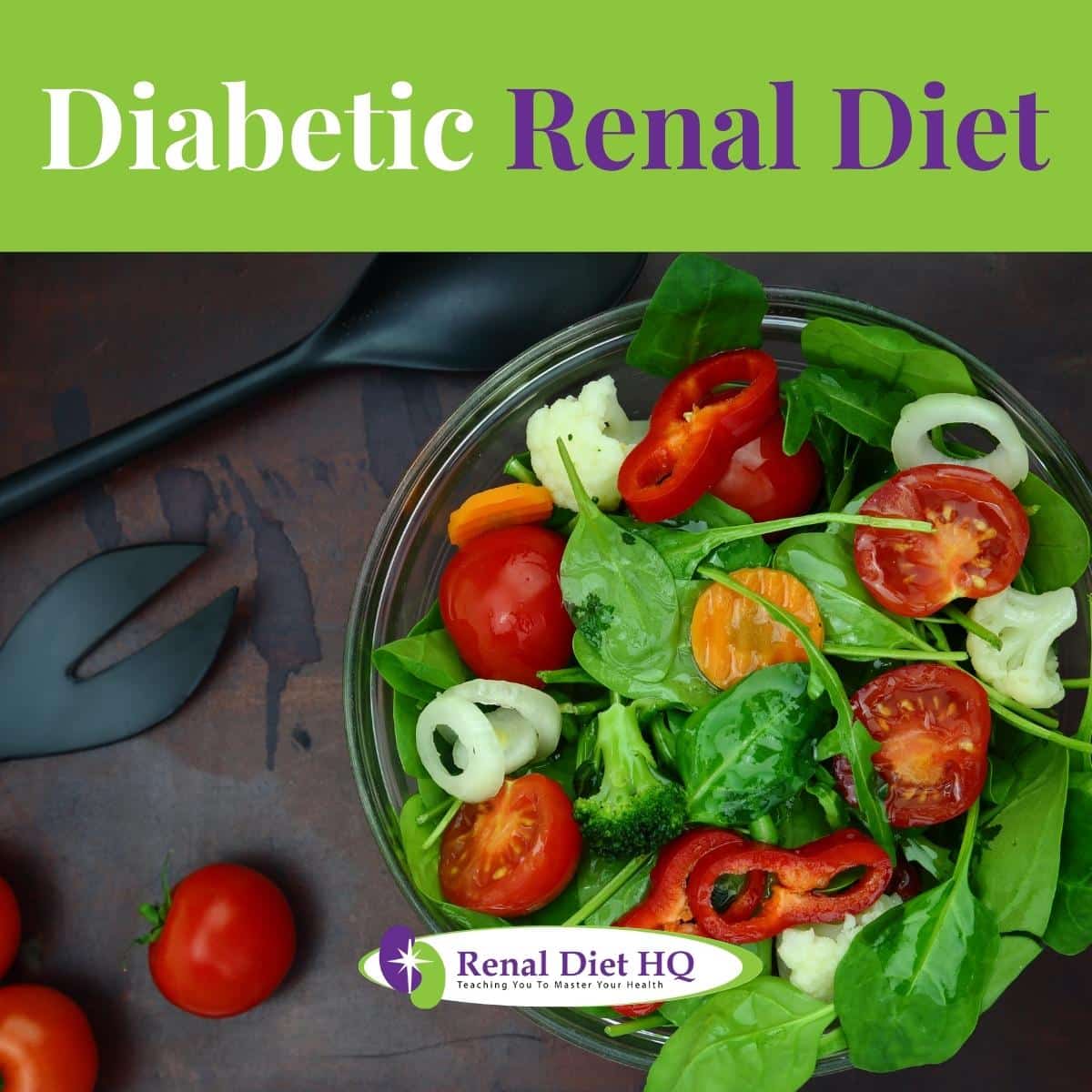
Diabetic Renal Diet
There are special considerations for a diabetic renal diet. Low sodium foods are important, as too much salt can cause fluid retention and worsen kidney function. Go ahead and check out this diabetic renal diet meal plan.
Low potassium foods are beneficial because they help keep potassium at normal levels. Low phosphorus foods can help keep phosphorus levels in the blood in check, which helps protect the kidneys from further damage.
Avoiding added sugar and being mindful of carbohydrate intake are especially important for people with kidney disease and diabetes to keep their blood sugar levels controlled.
All of these considerations can help keep a diabetic's kidneys healthy. Let's talk about some specific foods that are good for a diabetic renal diet.
Low Sodium Foods
It's important to find kidney-friendly snacks and recipes that are low in sodium, an essential part of managing diabetic kidney disease.
A great place to start is by using salt substitutes like potassium chloride or sea salt instead of regular table salt. When cooking with these salts, it's important to be mindful of portion sizes so as not to overdo it on added sodium in your favorite dishes. Overtime, you'll learn how to season food without salt.
Additionally, look for snack options such as fruits, vegetables, unsalted nuts and seeds, and whole grain crackers that make for tasty but healthy alternatives when trying to stick to a lower sodium intake.
Finally, there are numerous renal recipes out there utilizing ingredients from this kidney-friendly food list that can be incorporated into a healthy eating plan to ensure proper nutrition while still enjoying delicious meals!
Low Potassium Foods
Looking for more tips for a low potassium diet? When following a renal diet for diabetes, it's important to make sure you're also keeping an eye on your potassium intake. Opt for healthy choices low in potassium like red cabbage, cucumber, and legumes.
When combined with other nutritious snacks such as nuts or yogurt, these food swaps can still provide delicious meals while being mindful of the amount of potassium we consume each day.
It’s all about finding balance when trying to manage both diabetes and kidney disease – starting off with this list of foods for renal diet will ensure proper nutrition without compromising taste!
Low Phosphorus Foods
In a renal diabetic diet, it's also important to watch your phosphorus intake. Dairy products such as cheese and yogurt are naturally higher in phosphorus so finding dairy alternatives can help keep levels under control. Some of these replacements include soy or almond milk, tofu, and nut butter which all provide delicious sources of protein and healthy fats.
Additionally, some people may need to take phosphorus binders which act like sponges that absorb the mineral before it gets absorbed by the body - this helps reduce the amount of phosphorus being consumed. Check with your doctor to know if you need to add this into your medication regimen.
Low-Sugar/Low Carbohydrate Foods
Eating lower sugar and lower carbohydrate foods can be beneficial for a person with diabetes and kidney disease. Eating fewer carbohydrates can help to keep blood sugar levels in control, reducing the risk of complications and improving overall health. You can even find some low carb low potassium foods combinations.
One way to start reducing sugar and carbohydrates in the diet is to make some simple swaps. For example, instead of sugary drinks like soda or juice, swap them out for water or unsweetened tea. Learn more about soda and kidneys.
Other swaps include swapping white bread or white rice for whole wheat bread or brown rice, as these options contain more fiber and are absorbed more slowly to allow the body more time to process the carbohydrate.
Additionally, replacing sweet snacks like cookies or candy with fruits or vegetables can be a great way to reduce sugar and carbohydrates without sacrificing flavor.
In addition to the swaps mentioned, there are many other ways to reduce sugar and carbohydrates in the diet. Eating more whole foods like fruits, vegetables, and whole grains can help to reduce sugar and carbohydrate intake.
Additionally, reducing the amount of processed and fast food can also help to reduce sugar and carbohydrate intake. With some simple swaps, it is possible to reduce sugar and carbohydrates in the diet while still enjoying delicious and nutritious meals.
By focusing on making small changes one at a time, you can easily create meals that taste good while providing balanced nutrition for your diabetes and kidney disease management goals. Remember: Balance is key!
Cardiac Renal Diet
When it comes to a cardiac renal diet, there are certain foods to avoid, such as processed and fried foods, high-sodium foods, and high-potassium foods that can increase the risk for cardiovascular events such as a heart attack. On the other hand, foods like lean proteins, low-sodium vegetables, and whole grains are great options for people on a renal diet.
Additionally, you should make sure to drink plenty of fluids and get plenty of foods that are good sources of fiber as part of your renal diet. Lastly, it's important to speak with your doctor about your dietary needs to make sure you're eating the right foods for your specific needs.
Foods To Avoid
When you're following a cardiac renal diet, there are certain foods that should be avoided to keep your body healthy and functioning properly. When it comes to portion control, sodium intake, and hydration needs, it's important to know what not to eat in order to protect kidney health as well as heart health. High-salt items like salted snack foods, processed meats, soy sauce,
Worcestershire sauce, and canned soups can all cause an increase in blood pressure as well as strain on the blood vessels. Sodium is also found in many condiments such as mustard, ketchup, relish, and pickles. There are specific condiments for kidney disease you can use!
Foods high in saturated fat including fried food, full-fat dairy products, and red meat can lead to weight gain or higher cholesterol levels which put unnecessary stress on the heart and kidneys.
Lastly, sugary beverages like soda pop and energy drinks contain empty calories that add no nutritional value while providing excess sugar that could eventually damage the kidneys over time. So if you want to ensure proper kidney function make sure these foods stay off your plate!
Foods To Eat
When it comes to a cardiac renal diet, there are certain foods that should be included in meal planning and portion sizes. Meal prep for a kidney disease patient can also make it easier to stick to the right types of food while controlling sodium intake and making sure you're still getting enough hydration.
Eating plenty of fruits and vegetables is key as they provide essential vitamins and minerals that help promote overall health. Whole grains like quinoa, oats, brown rice, and barley offer fiber which helps keep cholesterol levels under control.
Excellent sources of lean protein such as fish or chicken give your body energy without adding extra saturated fat found in red meat. Low-fat dairy products like skim milk or Greek yogurt for CKD patients are great for calcium needs. Finally, drinking enough water based on your fluid restriction ensures proper hydration.
How To Read A Label For CKD Foods
When it comes to picking kidney friendly foods, reading the nutrition facts labels is essential. Knowing how to read a label for CKD-friendly foods can help you make better choices when stocking your pantry and planning meals.
This will help you keep track of your nutrient restrictions when making a renal diet grocery list.
Renal friendly snacks should be low in phosphorus, potassium, sodium, and saturated fat – all of which are easily identifiable on food labels. You should read labels carefully as a kidney patient.
Look for products that contain less than 150 mg of sodium per serving size; this will ensure that each snack fits within your dietary restrictions.
If there’s an ingredient list on the product packaging, look out for high-potassium ingredients such as bananas or potatoes. These may not always be listed in the nutrition facts section but they could still negatively impact your diet if included in large amounts.
For those times when you need more meal ideas beyond just snacks, try looking up recipes that have been specifically designed with kidney health in mind. Renal friendly recipes often incorporate lower-sodium options like herbs and spices instead of salt for flavorings.
They also use lean proteins and plenty of vegetables with no added salt so you don't overload on unhealthy levels of sodium and other electrolytes. With a little research online, you'll find tons of delicious recipes that fit into a healthy renal diet plan!
Making informed decisions about what goes into your body helps keep kidney problems at bay while helping optimize overall health too.
So next time you're grocery shopping or searching through cookbooks, remember to check nutrition labels and consider the type of recipe before adding any new items to your plate! You can even utilize this Comprehensive Healthy Renal Diet Grocery List Guide.
The National Renal Diet
The National Renal Diet is a great way to help manage kidney disease and improve your overall health. It can be quite daunting at first, but the right guidance and support can make the transition easier. Here are some tips for following this diet:
Eating out: When eating out, always check with your doctor or renal dietitian about what foods to order. Make sure you avoid high sodium items such as canned soups, cured meats, and pickled vegetables. Choose fresh fruits and vegetables when possible.
Hydration Tips: Staying hydrated on a renal diet is essential. Drink plenty of water throughout the day in small amounts rather than large quantities all at once.
Avoid sugary drinks like soda or sports drinks, and opt for low sugar alternatives instead. Here are several fluids to hydrate with kidney disease!
Exercise Advice: Regular exercise is an important part of any healthy lifestyle – especially if you have kidney disease! Start slowly by taking short walks each day and gradually increase the intensity over time.
Talk to your health care provider before starting any new exercises so they can provide advice tailored to your specific needs.
Meal Planning: Meal planning helps ensure that you’re getting enough nutrients while sticking to your renal diet restrictions.
Make a healthy eating plan by writing down meals two weeks in advance so you know exactly what ingredients to buy at the grocery store each week. Check out this 7 day meal plan for kidney disease.
Adopting a renal diet may seem challenging at first, but it doesn't have to be overwhelming - just take it one step at a time! With a little bit of preparation and dedication, you'll find that maintaining this type of diet can actually be enjoyable (and delicious!).
Printable Chart
The National Renal Diet, while not easy to follow, provides a necessary structure for those whose kidneys are compromised. With portion control and fluid restrictions, meal planning is essential to managing sodium intake and other dietary needs.
To make this easier on the patient, a printable chart can be used as an aid in keeping track of daily nutrition.
| Food Group | Serving Size |
| Vegetables | ½ cup cooked or 1 cup raw (1 serving = ¼ plate) |
| Fruits | ½ cup fresh or frozen fruit; 4 oz unsweetened juice (1 serving = ¼ plate) |
| Proteins: Meat/Dairy/Eggs/Beans/Nuts/Tofu etc. | 3-4 ounces lean meat; 2 tablespoons peanut butter; ½ cup tofu; ¾ cup cottage cheese (1 serving = ⅓ plate) |
| Grains: Bread/Cereals/Rice etc. | ½ slice whole-grain bread; ¼ bagel; ½ bun; 1 tortilla wrap; ½ cup cooked bran cereal, rice or wheat pasta (1 serving = ⅓ plate) |
This helpful guide will give patients the ability to plan their meals with better accuracy and understanding of what they should consume each day.
Additionally, it features suggestions for snacks that adhere to renal diet standards such as hard boiled eggs, cheese sticks, and celery with nut butter – all within the parameters of their kidney health guidelines.
In short, having access to this type of visual reminder empowers patients when making decisions related to their food consumption - allowing them to take more ownership over their own well-being.
High Protein Foods
High protein foods are an important part of a renal diet especially for those undergoing dialysis with end stage CKD. Modest protein restriction is recommended in earlier stages of the disease, but protein needs must still be met from high quality sources.
Protein rich foods provide necessary nutrients to help maintain healthy bodily functions and reduce the symptoms associated with chronic kidney disease (CKD). Eating high-protein foods can be difficult, but it is possible to enjoy meals while following this type of diet.
When planning meals on a healthy kidney diet, dairy substitutes such as soy milk, oat milk, or almond milk are great kidney-friendly options for adding extra protein into dishes.
Additionally, portion control plays a key role in helping you get the most out of your nutrition plan by allowing you to regulate how much food you’re consuming each day. Meal planning also helps make sure that all nutritional needs are met without having too many unhealthy snacks throughout the day.
For protein-rich snack ideas on a renal diet, consider roasted chickpeas, tuna salad wraps, and trail mix. These tasty treats will not only fill you up between meals, but they also have plenty of proteins that can keep you in great shape even while undergoing dialysis treatment.
Overall, eating high-protein foods on a renal diet doesn't have to feel like deprivation – with some creativity and planning ahead of time, there are plenty of nutrient-dense healthy options available!
Here’s a quick guide for managing your protein intake:
- Choose dairy substitutes like soy milk, oat milk, and almond milk
- Portion control for regulating food intake
- Creating a kidney-friendly eating plan for meeting all nutritional needs
- Eating healthy snacks like nuts, seeds, and fruit
Changes Based On Stage Of CKD
Stage 1 CKD usually involves making small dietary changes, such as limiting salt and phosphorus. It's important to remain mindful of the amount of protein and fluids consumed. For Stage 2 CKD, it's important to reduce protein and sodium intake and to increase fluids.
People with Stage 3 CKD should minimize their potassium, phosphorus, and protein intake. They should also monitor their fluid intake, as well as their intake of fruits and vegetables.
Stage 1 CKD
Stage 1 CKD is the earliest stage of chronic kidney disease, and can be managed with lifestyle modifications. It's important for those diagnosed to understand how their life may change as a result of this condition.
The emotional impact of receiving such news can be overwhelming, but there are ways to cope with it.
In Stage 1 CKD, diet restrictions may be recommended by medical professionals in order to reduce further damage to the kidneys or even slow down progression of kidney disease.
Such dietary changes include reducing sodium intake and following a DASH diet plan where you eat more fresh fruits and vegetables to lower blood pressure and have a healthier diet overall.
While these adjustments do take some getting used to, they can prevent renal failure and help patients maintain good health longer.
It's also worth noting that if left untreated or unmanaged, Stage 1 CKD could eventually lead to more serious complications - including needing dialysis treatments or even a kidney transplant!
Although this sounds daunting at first, understanding the potential risks associated with not taking care of your body can give you extra motivation to follow through your doctor’s recommendations and stay on top of your health management plan.
Stage 2 CKD
Moving on to Stage 2 CKD, the situation can become more complex. Patients may need to pay closer attention to salt restrictions, related conditions like diabetes, and portion sizes of their meals.
Putting together a meal plan for kidney disease is also a key factor in managing this stage of chronic kidney disease as it helps ensure that all nutritional needs are met while avoiding any foods that could potentially worsen the condition.
It's essential for those with Stage 2 CKD to understand how best to manage their diet in order to prevent further complications or even slow down progression of renal failure.
At stage 2 CKD it is still recommended to follow a DASH (Dietary Approaches to Stopping Hypertension) Diet that will contain more fruits and vegetables and improve health overall.
Although making dietary changes can be difficult at first, having a plan in place and sticking to it will make all the difference when it comes to maintaining overall health.
With proper management and adherence to guidelines, living with Stage 2 CKD doesn't have to mean completely giving up your favorite foods - rather, it is in learning how best to enjoy them in moderation.
Stage 3 CKD
Now, let's move on to Stage 3 CKD. It is important for patients in this stage of the disease to pay careful attention to their daily diet and nutrition, as well as making sure they are keeping up with their exercise routine. Here is a stage 3 kidney disease sample diet.
Eating out can be tricky, so it's best to make sure that meals chosen when dining out are healthy and nutritious - paying close attention to portion sizes, salt content, and potassium levels.
Water intake should also be monitored carefully; dehydration can worsen kidney health in those with Stage 3 CKD. Exercise tips from a healthcare professional or physical therapist can help ensure you're getting enough activity without overworking your body.
Lastly, regular check-ups are essential for ensuring proper management of chronic kidney disease. With these measures in place, individuals living with Stage 3 CKD can go about life feeling confident that they're doing all they can to keep their kidneys healthy.
At stage 3 with Chronic Kidney Disease, you start to lower your protein intake and watch your sodium intake closely. Aim to eat less than 2400 mg of sodium per day. You should also continue to manage and improve your related conditions like diabetes and heart disease.
Over-The-Counter Remedies
When choosing any type of over-the-counter remedy, it is important to consult your doctor first in order to avoid unwanted side effects or interactions with other medications you may take.
Additionally, though some supplements may seem beneficial based on their claims, they often don’t pass through rigorous safety testing so it is best to be cautious before using them.
In terms of cost management, many pharmacies offer generic versions of popular medicines at a much lower price point but with similar effectiveness when compared with brand name products.
This allows individuals to make informed decisions about what works best for their budget without compromising quality care for their renal needs.
Prescription Medications
Prescription medications are an important part of managing a renal diet. When prescribed by a doctor, they can help maintain healthy potassium and sodium levels in the body as well as keep other electrolyte balances in check. It is essential to take medications exactly as instructed by your physician or pharmacist.
Here are some tips for taking prescription drugs:
- Check with your doctor before taking any new over-the-counter medication that could affect kidney function.
- If you miss a dose, don't double up on doses later - instead, talk to your doctor about what to do next.
- Always follow directions carefully when it comes to fluid intake related to certain medications.
It's also wise to inform your healthcare team if you experience any adverse reactions after starting a new medication.
By doing so, you will ensure that you get the most out of your treatment plan while keeping yourself safe and healthy. You might even find that yourself saying "my doctor prescribed a renal diet."
FAQs for Renal Diet Food List
What Are The Long-Term Health Benefits Of Following A Renal Diet?
Following a renal diet can be one of the best long-term health decisions you make. Not only does it help protect your kidneys, but avoiding processed foods, exercising regularly, managing stress levels, and checking sodium intake can also have lasting benefits such as reducing cardiovascular risk factors.
Eating a renal diet helps to improve overall wellness by providing essential vitamins and minerals to support healthy organs and systems, as well as promoting proper digestion and metabolism.
It can also boost energy levels while reducing inflammation in the body and helping with maintaining a healthy weight. A renal diet is an easy way to take control of your health and ensure that you’re living your life at its fullest potential despite living with CKD!
Are There Any Specific Dietary Supplements Recommended For People With Chronic Kidney Disease?
For those with chronic kidney disease, taking dietary supplements is an important step in managing their condition. Specific supplements can help reduce inflammation, meet hydration guidelines and exercise recommendations, as well as prevent nutrient deficiencies. You can view exercise for CKD Patients.
Some general supplements to consider for people with chronic kidney disease include omega-3 fatty acids and vitamins D and B12. However, individuals should talk to their doctor about adding any specific dietary supplements to their regimen to prevent adverse health effects.
How Often Should A Person With Chronic Kidney Disease Have Their Blood Tested?
For those living with chronic kidney disease, monitoring their health is of utmost importance. This includes having your blood tested regularly to ensure you are to help keep an eye on electrolyte levels and determine whether there is a need to adjust your medications.
How often should a person with CKD have their blood tested? Most healthcare professionals recommend that someone with CKD get their blood drawn at least every three months in order to keep track of health changes - although it can be more frequent depending on the individual's needs.
By staying ahead of potential problems and following doctor-recommended guidelines, managing one’s health becomes easier over time.
Are There Any Lifestyle Changes That Can Improve Kidney Health?
Managing your lifestyle is one of the most important things you can do for improving kidney health. Making sure to manage stress, exercise regularly, avoiding processed foods and limiting salt intake are all key components in keeping kidneys healthy.
While it may sound difficult, these simple changes can have a powerful effect on organ health and functioning. It's also worth noting that making small improvements over time adds up - so don't be discouraged by what may seem like slow progress!
Are There Any Foods That Can Help To Reduce Creatinine Levels In People With Chronic Kidney Disease?
Creatinine refers to waste products that mainly reflect the extent of remaining normal function of your kidney. Hence, levels of this substance depend on your residual kidney function.
Certain foods can help reduce creatinine levels in people with chronic kidney disease who follow a renal kidney-friendly. Eating a healthful diet that is low in sodium and high in dietary fiber with foods such as fruits, vegetables, and whole grains is key to managing CKD.
Additionally, limiting animal protein intake may be beneficial as well. Foods like avocados, almonds, garlic, olive oil, apples, and blueberries are particularly beneficial for liver health.
Diet planning also needs to accompany an exercise program tailored to your activity level. The benefits of regular physical activity should not be overlooked as they can improve overall health while helping maintain weight goals. Take a look at these exercise mistakes to avoid with ckd.
It's important to stay hydrated by drinking adequate amounts of water throughout the day, too!
Get Started For The Health Benefits!
Following a kidney-friendly diet can be the key to improved kidney health and overall wellbeing. By making dietary changes, taking recommended supplements, and regularly monitoring their blood work, people with chronic kidney disease can protect their long-term health.
Additionally, by making lifestyle modifications such as regular exercise, they can give themselves an extra layer of protection against further damage.
Taking care of our bodies is tantamount to ensuring a healthy future for ourselves. With the right renal diet, you get a long list of health benefits, so get started today!






